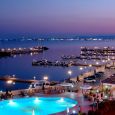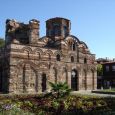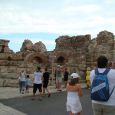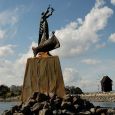Nesebar
Advertisement
By Air
Airports nearest to Nesebar are sorted by the distance to the airport from the city centre.
Burgas Airport (distanced approximately 8.7 km)
Jambol Airport (distanced approximately 81 km)
Varna Airport (distanced approximately 86 km)
Stara Zagora Airport (distanced approximately 150 km)
Teklrdag Corlu Airport (distanced approximately 160 km)
Church of St. John the Baptist
The Church of St. John the Baptist is a cruciform church located in Nessebar, Bulgaria.The Church of St. John the Baptist is a domed cruciform church, built of undressed stone.It is one of the best preserved churchs in Nessebar.It is 12 meters long and 10 wide.The structure of the church consists of two cylindrical vaults which intersect in the center of the composition.The masonry is crushed stone and pebbles and the facades were probably smoothly plastered.It was built in the 10th century.It has no narthex.The altar space consists of three semi-circular apses.Four massive pillars support the dome and form the cross.Inside the church the walls are smooth and unbroken.
Church of St. Theodore
The Church of St. Theodore in Nesebar, Bulgaria, was built in the 13th century and the north and western façades survive from this era.The other walls and the roof were built later.It is a single nave church with a narthex and apse.The church is 8.70 m long and wide 4.15 m wide.The façade is decorated with blind arches of worked stone and brick.The space under the arches is ornamented with staggered zigzag patterns of stone blocks and bricks.There is also an art gallery inside.
Church of St. Paraskevi
is a partially preserved medieval Eastern Orthodox church in Nesebar (medieval Mesembria), a town on the Black Sea coast of Burgas Province in eastern Bulgaria.It was most likely built in the 13th or 14th century and forms part of the Ancient Nesebar UNESCO World Heritage Site.The Church of Saint Paraskevi features a single nave and a pentagonal apse as well as rich exterior decoration.Its dome and the belfry surmounting the narthex have not been preserved today and it is unknown which of the three saints named Paraskevi it was dedicated to.
Church of St. Spas
The Church of the Holy Saviour or Sveti Spas in the UNESCO World Heritage town of Nesebar, Bulgaria, is a 17th century church building of 1609, 11.70 m long and 5.70 m wide, consisting of a single nave and apse.Although small it is notable for its early 17th century wall paintings representing scenes from the Life of Christ and the Holy Virgin, with a painting of the Virgin Platytera in the apse.The tombstone of the Byzantine princess Mataissa Cantacuzina formerly here is now in the Nesebar Archaeological Museum.The church itself is de-consecrated and is also used as a museum.
Nessebar Archaeological Museum
is one of the oldest Bulgarian towns populated by settlers from the town of Megara and its colonies Byzantium and Kalhedon at the end of VI century BC.Until the arrival of the Bulgarian village was of Thracian and Greek type.The city is included within the boundaries of Bulgaria in 812, when Khan Krum conquered it and its population is enriched by Slavs and Bulgarians.Later over a longer period of Nessebar (as they call it the Slavs) was again in the management of Bulgarian Tsar Simeon the Great.For this reason in 1994 was opened and the archaeological museum in the city and much of the exhibits included in the exhibition, covering the foyer and four halls.It is included in the hundred tourist sites.In the lobby is at the diploma of UNESCO, documenting enrollment in 1983 of the old town of Nessebar UNESCO World Heritage Site.
Nessebar Ethnographic Museum
The museum is in an old house from National Revival, built in 1840 on the south coast of the peninsula.The house is typical for the late residential architecture of Nessebar and was property of a rich tradesman Panayiot Moskoyani.The building has two floors - ground floor and upper floor.The ground floor is in stone, high with two ails door.The upper housing floor is with jetties and edged with wooden planks.It has many high windows viewing to the sea.The five rooms are situated around a hall with a wood carved selling, decorated in the middle by a star-rosette.Northern rooms, used in winter have fire-places.
May - October






